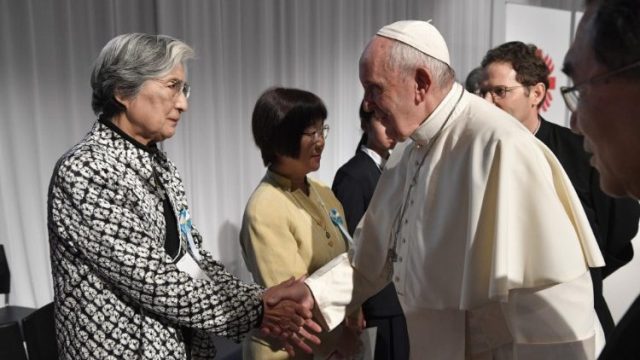The 82-year-old Argentinian pope, who arrived in Japan on Saturday for a four-day visit, listened to the accounts of three survivors of the disaster.
One of the survivors was Matsuki Kamoshita, a high school student who had to leave their home in the city of Iwaki, just south of the Fukushima Daiichi Nuclear Power Station “to escape radiation” following the disaster.
The plant suffered meltdowns at three of its reactors after it was hit by a powerful quake and resulting tsunami, which killed about 18,500 people.
Kamoshita’s mother took him and his younger brother and continued to evacuate from place to place while his father had to work in Fukushima as a teacher, he said.
“I was bullied in the evacuation destination and every day was so painful I wanted to die,” while his father became mentally and physically ill and stopped working, the 17-year-old said.
Tens of thousands of people like Kamoshita remain unable to return home near the plant due to fears of radiation contamination.
However, “many people have been forced to return to the contaminated area” near the plant, he said.
“In the ongoing work of recovery and rebuilding after the triple disaster, many hands must join together and many hearts unite as one,” the pope said, so the victims of the disaster can receive support and know they have not been forgotten.
The pope pointed out scientific and medical concerns about the nuclear disaster and also saw “the immense challenge of restoring the fabric of society.”
He also questioned the continued use of nuclear power as the Japanese bishops urge the country to abandon nuclear power.
The pope also visited the Imperial Palace to hold a meeting with Emperor Naruhito, who took the Chrysanthemum throne on May 1.
The emperor thanked the pope for visiting Nagasaki and Hiroshima and meeting victims of the 2011 tsunami and nuclear disaster.
Francis is also scheduled to hold talks with Prime Minister Shinzo Abe later in the day, after holding a mass at a baseball stadium in the capital.
On Sunday, the 82-year-old travelled to Nagasaki and Hiroshima, where he paid tribute to the victims of US atomic bombings on the two cities in 1945.
The pope described the use of atomic energy for purposes of war as a “crime,” and urged the world to abandon nuclear weapons.
In Nagasaki, where Christianity first took root in Japan, the pope held a mass at the city’s baseball stadium with some 30,000 people in attendance.
His tour marks the first papal visit to the country in 38 years.
In 1981, Pope John Paul II visited Hiroshima, Nagasaki, and Tokyo.




 Premier League
Premier League